Deck 11: Streams and Floods
سؤال
سؤال
سؤال
سؤال
سؤال
سؤال
سؤال
سؤال
سؤال
سؤال
سؤال
سؤال
سؤال
سؤال
سؤال
سؤال
سؤال
سؤال
سؤال
سؤال
سؤال
سؤال
سؤال
سؤال
سؤال
سؤال
سؤال
سؤال
سؤال
سؤال
سؤال
سؤال
سؤال
سؤال
سؤال
سؤال
سؤال
سؤال
سؤال
سؤال
سؤال
سؤال
سؤال
سؤال
سؤال
سؤال
سؤال
سؤال

فتح الحزمة
قم بالتسجيل لفتح البطاقات في هذه المجموعة!
Unlock Deck
Unlock Deck
1/48
العب
ملء الشاشة (f)
Deck 11: Streams and Floods
1
Where are stream loads deposited?
A) On the inside of a bend where velocity is lower
B) On the inside of a bend where the velocity is higher
C) On the outside of a bend where the velocity is lower
D) On the outside of a bend where the velocity is higher
A) On the inside of a bend where velocity is lower
B) On the inside of a bend where the velocity is higher
C) On the outside of a bend where the velocity is lower
D) On the outside of a bend where the velocity is higher
On the inside of a bend where velocity is lower
2
Where do stream channels experience the most erosion?
A) On the inside of a bend where velocity is lower
B) On the inside of a bend where the velocity is higher
C) On the outside of a bend where the velocity is lower
D) On the outside of a bend where the velocity is higher
A) On the inside of a bend where velocity is lower
B) On the inside of a bend where the velocity is higher
C) On the outside of a bend where the velocity is lower
D) On the outside of a bend where the velocity is higher
On the outside of a bend where the velocity is higher
3
Which statement about the stream cross-sectional velocity is true?
A) Velocity is lowest in the center where friction is highest.
B) Velocity is highest in the center where friction is lowest.
C) Velocity is lowest in the center where friction is lowest.
D) Velocity is highest in the center where friction is highest.
A) Velocity is lowest in the center where friction is highest.
B) Velocity is highest in the center where friction is lowest.
C) Velocity is lowest in the center where friction is lowest.
D) Velocity is highest in the center where friction is highest.
Velocity is highest in the center where friction is lowest.
4
Which statement about lateral migration is true?
A) Streams migrate in the direction of erosion.
B) Streams migrate opposite the direction of erosion.
C) Streams migrate without regard to erosion.
A) Streams migrate in the direction of erosion.
B) Streams migrate opposite the direction of erosion.
C) Streams migrate without regard to erosion.

فتح الحزمة
افتح القفل للوصول البطاقات البالغ عددها 48 في هذه المجموعة.
فتح الحزمة
k this deck
5
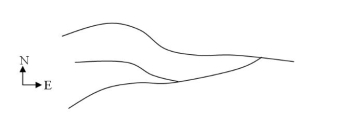 What direction is the stream flowing in this image?
What direction is the stream flowing in this image?A) East
B) West
C) No way to tell

فتح الحزمة
افتح القفل للوصول البطاقات البالغ عددها 48 في هذه المجموعة.
فتح الحزمة
k this deck
6
The following diagram illustrates the Hydrologic Cycle. Match the letters below to the arrow on the diagram (note: some letters may be used for more than one arrow).
Example: If you believe that water passes from clouds to streams by evaporation then choose answer a) for arrow 3.

-Match the letters below to the arrow on the diagram for number 1. (Note: some letters may be used for more than one arrow).
A) Evaporation
B) Infiltration
C) Transpiration
D) Runoff
E) Precipitation
Example: If you believe that water passes from clouds to streams by evaporation then choose answer a) for arrow 3.

-Match the letters below to the arrow on the diagram for number 1. (Note: some letters may be used for more than one arrow).
A) Evaporation
B) Infiltration
C) Transpiration
D) Runoff
E) Precipitation

فتح الحزمة
افتح القفل للوصول البطاقات البالغ عددها 48 في هذه المجموعة.
فتح الحزمة
k this deck
7
The following diagram illustrates the Hydrologic Cycle. Match the letters below to the arrow on the diagram (note: some letters may be used for more than one arrow).
Example: If you believe that water passes from clouds to streams by evaporation then choose answer a) for arrow 3.

-Match the letters below to the arrow on the diagram for number 2. (Note: some letters may be used for more than one arrow).
A) Evaporation
B) Infiltration
C) Transpiration
D) Runoff
E) Precipitation
Example: If you believe that water passes from clouds to streams by evaporation then choose answer a) for arrow 3.

-Match the letters below to the arrow on the diagram for number 2. (Note: some letters may be used for more than one arrow).
A) Evaporation
B) Infiltration
C) Transpiration
D) Runoff
E) Precipitation

فتح الحزمة
افتح القفل للوصول البطاقات البالغ عددها 48 في هذه المجموعة.
فتح الحزمة
k this deck
8
The following diagram illustrates the Hydrologic Cycle. Match the letters below to the arrow on the diagram (note: some letters may be used for more than one arrow).
Example: If you believe that water passes from clouds to streams by evaporation then choose answer a) for arrow 3.

-Match the letters below to the arrow on the diagram for number 3. (Note: some letters may be used for more than one arrow).
A) Evaporation
B) Infiltration
C) Transpiration
D) Runoff
E) Precipitation
Example: If you believe that water passes from clouds to streams by evaporation then choose answer a) for arrow 3.

-Match the letters below to the arrow on the diagram for number 3. (Note: some letters may be used for more than one arrow).
A) Evaporation
B) Infiltration
C) Transpiration
D) Runoff
E) Precipitation

فتح الحزمة
افتح القفل للوصول البطاقات البالغ عددها 48 في هذه المجموعة.
فتح الحزمة
k this deck
9
The following diagram illustrates the Hydrologic Cycle. Match the letters below to the arrow on the diagram (note: some letters may be used for more than one arrow).
Example: If you believe that water passes from clouds to streams by evaporation then choose answer a) for arrow 3.

-Match the letters below to the arrow on the diagram for number 4. (Note: some letters may be used for more than one arrow).
A) Evaporation
B) Infiltration
C) Transpiration
D) Runoff
E) Precipitation
Example: If you believe that water passes from clouds to streams by evaporation then choose answer a) for arrow 3.

-Match the letters below to the arrow on the diagram for number 4. (Note: some letters may be used for more than one arrow).
A) Evaporation
B) Infiltration
C) Transpiration
D) Runoff
E) Precipitation

فتح الحزمة
افتح القفل للوصول البطاقات البالغ عددها 48 في هذه المجموعة.
فتح الحزمة
k this deck
10
The following diagram illustrates the Hydrologic Cycle. Match the letters below to the arrow on the diagram (note: some letters may be used for more than one arrow).
Example: If you believe that water passes from clouds to streams by evaporation then choose answer a) for arrow 3.

-Match the letters below to the arrow on the diagram for number 5. (Note: some letters may be used for more than one arrow).
A) Evaporation
B) Infiltration
C) Transpiration
D) Runoff
E) Precipitation
Example: If you believe that water passes from clouds to streams by evaporation then choose answer a) for arrow 3.

-Match the letters below to the arrow on the diagram for number 5. (Note: some letters may be used for more than one arrow).
A) Evaporation
B) Infiltration
C) Transpiration
D) Runoff
E) Precipitation

فتح الحزمة
افتح القفل للوصول البطاقات البالغ عددها 48 في هذه المجموعة.
فتح الحزمة
k this deck
11
The following diagram illustrates the Hydrologic Cycle. Match the letters below to the arrow on the diagram (note: some letters may be used for more than one arrow).
Example: If you believe that water passes from clouds to streams by evaporation then choose answer a) for arrow 3.

-Match the letters below to the arrow on the diagram for number 6. (Note: some letters may be used for more than one arrow).
A) Evaporation
B) Infiltration
C) Transpiration
D) Runoff
E) Precipitation
Example: If you believe that water passes from clouds to streams by evaporation then choose answer a) for arrow 3.

-Match the letters below to the arrow on the diagram for number 6. (Note: some letters may be used for more than one arrow).
A) Evaporation
B) Infiltration
C) Transpiration
D) Runoff
E) Precipitation

فتح الحزمة
افتح القفل للوصول البطاقات البالغ عددها 48 في هذه المجموعة.
فتح الحزمة
k this deck
12
The following diagram illustrates the Hydrologic Cycle. Match the letters below to the arrow on the diagram (note: some letters may be used for more than one arrow).
Example: If you believe that water passes from clouds to streams by evaporation then choose answer a) for arrow 3.

-Match the letters below to the arrow on the diagram for number 7. (Note: some letters may be used for more than one arrow).
A) Evaporation
B) Infiltration
C) Transpiration
D) Runoff
E) Precipitation
Example: If you believe that water passes from clouds to streams by evaporation then choose answer a) for arrow 3.

-Match the letters below to the arrow on the diagram for number 7. (Note: some letters may be used for more than one arrow).
A) Evaporation
B) Infiltration
C) Transpiration
D) Runoff
E) Precipitation

فتح الحزمة
افتح القفل للوصول البطاقات البالغ عددها 48 في هذه المجموعة.
فتح الحزمة
k this deck
13
The following diagram illustrates the Hydrologic Cycle. Match the letters below to the arrow on the diagram (note: some letters may be used for more than one arrow).
Example: If you believe that water passes from clouds to streams by evaporation then choose answer a) for arrow 3.

-Match the letters below to the arrow on the diagram for number 8. (Note: some letters may be used for more than one arrow).
A) Evaporation
B) Infiltration
C) Transpiration
D) Runoff
E) Precipitation
Example: If you believe that water passes from clouds to streams by evaporation then choose answer a) for arrow 3.

-Match the letters below to the arrow on the diagram for number 8. (Note: some letters may be used for more than one arrow).
A) Evaporation
B) Infiltration
C) Transpiration
D) Runoff
E) Precipitation

فتح الحزمة
افتح القفل للوصول البطاقات البالغ عددها 48 في هذه المجموعة.
فتح الحزمة
k this deck
14
The following diagram illustrates the Hydrologic Cycle. Match the letters below to the arrow on the diagram (note: some letters may be used for more than one arrow).
Example: If you believe that water passes from clouds to streams by evaporation then choose answer a) for arrow 3.

-Match the letters below to the arrow on the diagram for number 10. (Note: some letters may be used for more than one arrow).
A) Evaporation
B) Infiltration
C) Transpiration
D) Runoff
E) Precipitation
Example: If you believe that water passes from clouds to streams by evaporation then choose answer a) for arrow 3.

-Match the letters below to the arrow on the diagram for number 10. (Note: some letters may be used for more than one arrow).
A) Evaporation
B) Infiltration
C) Transpiration
D) Runoff
E) Precipitation

فتح الحزمة
افتح القفل للوصول البطاقات البالغ عددها 48 في هذه المجموعة.
فتح الحزمة
k this deck
15
Use the Hydrologic Cycle diagram to answer this question.
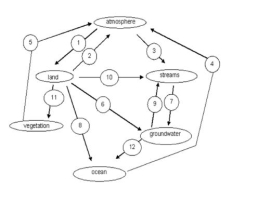
-In a humid climate, which process contributes the greatest volume of water?
A) Arrow 3
B) Arrow 9
C) Arrow 10

-In a humid climate, which process contributes the greatest volume of water?
A) Arrow 3
B) Arrow 9
C) Arrow 10

فتح الحزمة
افتح القفل للوصول البطاقات البالغ عددها 48 في هذه المجموعة.
فتح الحزمة
k this deck
16
Use the Hydrologic Cycle diagram to answer this question.

-In an arid climate, which process contributes the greatest volume of water?
A) Arrow 3
B) Arrow 9
C) Arrow 10

-In an arid climate, which process contributes the greatest volume of water?
A) Arrow 3
B) Arrow 9
C) Arrow 10

فتح الحزمة
افتح القفل للوصول البطاقات البالغ عددها 48 في هذه المجموعة.
فتح الحزمة
k this deck
17
What happens to the volume of water that passes from groundwater to streams during a prolonged drought?
A) It increases
B) It decreases
C) No change
A) It increases
B) It decreases
C) No change

فتح الحزمة
افتح القفل للوصول البطاقات البالغ عددها 48 في هذه المجموعة.
فتح الحزمة
k this deck
18
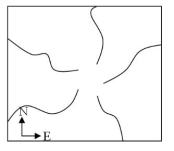
-Why did the stream pattern shown above develop?
A) The surface geology is probably very uniform.
B) This is probably an area with alternating layers of weak and resistant rock.
C) This is probably a volcanic area.

فتح الحزمة
افتح القفل للوصول البطاقات البالغ عددها 48 في هذه المجموعة.
فتح الحزمة
k this deck
19
Use this stream-related diagram to answer the following questions.
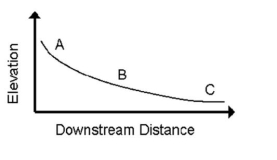
-Where is the highest average stream velocity?
A) Point A
B) Point B
C) Point C

-Where is the highest average stream velocity?
A) Point A
B) Point B
C) Point C

فتح الحزمة
افتح القفل للوصول البطاقات البالغ عددها 48 في هذه المجموعة.
فتح الحزمة
k this deck
20
Use this stream-related diagram to answer the following questions.

-Where is the highest gradient?
A) Point A
B) Point B
C) Point C

-Where is the highest gradient?
A) Point A
B) Point B
C) Point C

فتح الحزمة
افتح القفل للوصول البطاقات البالغ عددها 48 في هذه المجموعة.
فتح الحزمة
k this deck
21
Use this stream-related diagram to answer the following questions.

-Predict where channel roughness is greatest.
A) Point A
B) Point B
C) Point C

-Predict where channel roughness is greatest.
A) Point A
B) Point B
C) Point C

فتح الحزمة
افتح القفل للوصول البطاقات البالغ عددها 48 في هذه المجموعة.
فتح الحزمة
k this deck
22
Use the following idealized stream channel to answer this question.

-What is the discharge?
A) XYZ
B) XYY
C) X+Y+Y
D) X+Y+Z

-What is the discharge?
A) XYZ
B) XYY
C) X+Y+Y
D) X+Y+Z

فتح الحزمة
افتح القفل للوصول البطاقات البالغ عددها 48 في هذه المجموعة.
فتح الحزمة
k this deck
23
Use the following idealized stream channel to answer this question.

-What is the wetted perimeter?
A) XYZ
B) XYY
C) X+Y+Y
D) X+Y+Z

-What is the wetted perimeter?
A) XYZ
B) XYY
C) X+Y+Y
D) X+Y+Z

فتح الحزمة
افتح القفل للوصول البطاقات البالغ عددها 48 في هذه المجموعة.
فتح الحزمة
k this deck
24
Use the diagram to answer this question.

-Where is the cut bank?
A) Point a
B) Point b
C) Point c
D) Point d

-Where is the cut bank?
A) Point a
B) Point b
C) Point c
D) Point d

فتح الحزمة
افتح القفل للوصول البطاقات البالغ عددها 48 في هذه المجموعة.
فتح الحزمة
k this deck
25
Use the diagram to answer this question.

-Where is the most deposition occurring?
A) Point a
B) Point b
C) Point c
D) Point d

-Where is the most deposition occurring?
A) Point a
B) Point b
C) Point c
D) Point d

فتح الحزمة
افتح القفل للوصول البطاقات البالغ عددها 48 في هذه المجموعة.
فتح الحزمة
k this deck
26
Use the diagram to answer this question.

-What happens when fresh water in an aquifer comes in contact with salt water?
A) The fresh water floats because it is usually less dense than salt water.
B) The fresh water floats because it is usually more dense than salt water.
C) The fresh water sinks because it is usually more dense than salt water.
D) The fresh water sinks because it is usually less dense than salt water.

-What happens when fresh water in an aquifer comes in contact with salt water?
A) The fresh water floats because it is usually less dense than salt water.
B) The fresh water floats because it is usually more dense than salt water.
C) The fresh water sinks because it is usually more dense than salt water.
D) The fresh water sinks because it is usually less dense than salt water.

فتح الحزمة
افتح القفل للوصول البطاقات البالغ عددها 48 في هذه المجموعة.
فتح الحزمة
k this deck
27
The following diagram illustrates streams in a set of drainage basins.
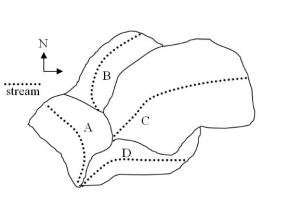
-All other variables related to stream size being equal, which stream in the diagram above will have the largest discharge?
A) A
B) B
C) C
D) D

-All other variables related to stream size being equal, which stream in the diagram above will have the largest discharge?
A) A
B) B
C) C
D) D

فتح الحزمة
افتح القفل للوصول البطاقات البالغ عددها 48 في هذه المجموعة.
فتح الحزمة
k this deck
28
Globally, what is the largest source of fresh water?
A) Groundwater
B) Great Lakes
C) Glacial ice
A) Groundwater
B) Great Lakes
C) Glacial ice

فتح الحزمة
افتح القفل للوصول البطاقات البالغ عددها 48 في هذه المجموعة.
فتح الحزمة
k this deck
29
Suppose a stream flows from its headwaters, through a reservoir to its mouth in the Gulf of Mexico. Where is ultimate base level?
A) At the Gulf of Mexico
B) At the reservoir
C) At the headwaters
A) At the Gulf of Mexico
B) At the reservoir
C) At the headwaters

فتح الحزمة
افتح القفل للوصول البطاقات البالغ عددها 48 في هذه المجموعة.
فتح الحزمة
k this deck
30
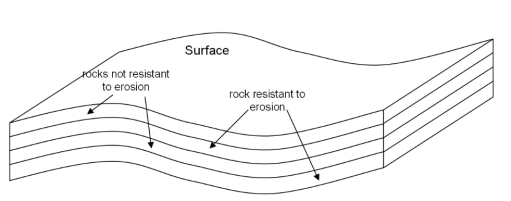
-Which stream pattern would most likely develop based on the geology shown above?
A) Radial
B) Trellis
C) Dendritic

فتح الحزمة
افتح القفل للوصول البطاقات البالغ عددها 48 في هذه المجموعة.
فتح الحزمة
k this deck
31

-What can one deduce (figure out) about a region by analyzing stream patterns in an aerial photograph or a map?
A) The geology beneath a stream
B) The age of the stream
C) The discharge of a stream

فتح الحزمة
افتح القفل للوصول البطاقات البالغ عددها 48 في هذه المجموعة.
فتح الحزمة
k this deck
32

-What happens to the amount of stream discharge from the source to the mouth?
A) Increases
B) Decreases
C) Stays about the same

فتح الحزمة
افتح القفل للوصول البطاقات البالغ عددها 48 في هذه المجموعة.
فتح الحزمة
k this deck
33

-Which load is responsible for the most stream erosion?
A) Suspended load
B) Bed load
C) Dissolved load

فتح الحزمة
افتح القفل للوصول البطاقات البالغ عددها 48 في هذه المجموعة.
فتح الحزمة
k this deck
34
What principle type of load removes the material where there are caves?
A) Bed load
B) Suspended load
C) Dissolved load
A) Bed load
B) Suspended load
C) Dissolved load

فتح الحزمة
افتح القفل للوصول البطاقات البالغ عددها 48 في هذه المجموعة.
فتح الحزمة
k this deck
35
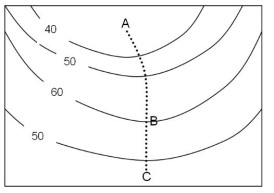
-In the diagram shown above, what direction would the stream (shown as a dashed line) flow? (Numbers represent elevation in meters above sea level.)
A) From A to C
B) From C to A
C) Away from B

فتح الحزمة
افتح القفل للوصول البطاقات البالغ عددها 48 في هذه المجموعة.
فتح الحزمة
k this deck
36

-For the diagram above, which stage would exhibit the largest discharge for the cross section of the stream assuming velocity is constant?
A) A.
B) B.
C) C.

فتح الحزمة
افتح القفل للوصول البطاقات البالغ عددها 48 في هذه المجموعة.
فتح الحزمة
k this deck
37
Which of the following is not a flood prevention measure?
A) Levees
B) Dams
C) Flood insurance
A) Levees
B) Dams
C) Flood insurance

فتح الحزمة
افتح القفل للوصول البطاقات البالغ عددها 48 في هذه المجموعة.
فتح الحزمة
k this deck
38
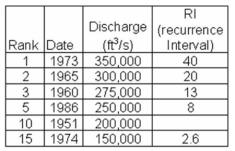
-Use the data shown to determine recurrence intervals for the river. This river has had 39 floods over the past 100 years. What is the recurrence interval for the 10th ranked flood?
A) 3
B) 4
C) 5

فتح الحزمة
افتح القفل للوصول البطاقات البالغ عددها 48 في هذه المجموعة.
فتح الحزمة
k this deck
39
Most rivers flow from north to south in the northern hemisphere which is opposite that of the southern hemisphere.

فتح الحزمة
افتح القفل للوصول البطاقات البالغ عددها 48 في هذه المجموعة.
فتح الحزمة
k this deck
40
Liquid water can exist at 0° C.

فتح الحزمة
افتح القفل للوصول البطاقات البالغ عددها 48 في هذه المجموعة.
فتح الحزمة
k this deck
41
The headwaters of a stream are where it empties to local or ultimate base level.

فتح الحزمة
افتح القفل للوصول البطاقات البالغ عددها 48 في هذه المجموعة.
فتح الحزمة
k this deck
42
Flood plains are depositional features.

فتح الحزمة
افتح القفل للوصول البطاقات البالغ عددها 48 في هذه المجموعة.
فتح الحزمة
k this deck
43
Construction of an asphalt parking lot at a mall is likely to increase local flooding by increasing infiltration rates.

فتح الحزمة
افتح القفل للوصول البطاقات البالغ عددها 48 في هذه المجموعة.
فتح الحزمة
k this deck
44
Floods usually only affect human development in flood plains.

فتح الحزمة
افتح القفل للوصول البطاقات البالغ عددها 48 في هذه المجموعة.
فتح الحزمة
k this deck
45
Floods can occur in winter.

فتح الحزمة
افتح القفل للوصول البطاقات البالغ عددها 48 في هذه المجموعة.
فتح الحزمة
k this deck
46
Wetlands help to minimize the effects flooding.

فتح الحزمة
افتح القفل للوصول البطاقات البالغ عددها 48 في هذه المجموعة.
فتح الحزمة
k this deck
47
Floods only occur when there is excessive short-term precipitation or a dam failure.

فتح الحزمة
افتح القفل للوصول البطاقات البالغ عددها 48 في هذه المجموعة.
فتح الحزمة
k this deck
48
Flood insurance prevents losses from floods.

فتح الحزمة
افتح القفل للوصول البطاقات البالغ عددها 48 في هذه المجموعة.
فتح الحزمة
k this deck








